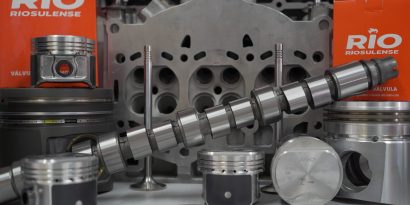The hydraulic tappet, a well-known component to the EXPERT repair technician, is fundamental in providing compression and the healthy functioning of engines. Ultimately, all automotive engines have a great quantity of valves, and every valve normally has an attributed tappet, a set of components that function in synchrony, aligned to the movement of the camshaft.
This is because tappets are components responsible for transmitting the camshaft movements to the push rods of the rocker arms, and of course, eliminate the usual clearance of the set. In other words, the tappet is a part whose performance will affect directly the capacity and quality of combustion, by affecting the mixture between air and fuel in the combustion chambers.
Understanding the role of the hydraulic tappet in the engine block
In a previous article here on our blog, we explained how the valve tappet works in conjunction with push rods, valves and springs, in order to guarantee greater precision and a hermetic seal during the flow of both intake and exhaust from the chamber. But, considering the functioning of this component, a more detailed explanation is in order.
To begin with, it is very important to remind ourselves that the tappet is connected to both a rocker and the oil pressure channel. Through the oil pressure channel oil passes by the tappet and is discharged onto the rocker, in so lubricating the point of contact between the rocker and the camshaft.
The function of the tappet is to close the clearance between the camshaft and the rocker arm, eliminating the necessity for adjustments of the component, as well as other adjustments in amplitude, which when not aligned and positioned correctly may harm engine performance.
Technology to enhance performance and reduce wear
As we have seen, repair technicians may be more used to traditional mechanical tappets, more robust and solid components, and they may find hydraulic tappets peculiar due to their hollow structure. However, the reasoning behind the hydraulic tappet’s structure is that it affords it a a cylinder like design with a piston at its end, much like a ballpoint pen.
The piston is kept on the outside of the valve tappet due to the force of a spring, while the hydraulic tappet is completely filled by lubricant engine oil, which enters the tappet through a small hole located on the side of the cylinder.
This means that the clearance between the camshaft and the tappet, indispensable for mechanical tappets, are not necessary for hydraulic tappets. Remember that the oil pump makes it so that the opening and closing of the valves produce an exchange of the lubricating oil found within the tappet. This avoids the production of air bubbles and permits more efficient heat exchange.
And this is why it is crucial to respect the lubricant oil specifications stated for your vehicle by the manufacturer. Always keep in mind that the hydraulic tappets have extremely small holes through which lubricant engine oil passes. These passageways are projected to permit a specified flow of lubricant oil during operation.
Or be it, this projected flow of lubricant engine oil may be negatively affected due to the use of an unintended lubricant engine oil with a differing viscosity rating. This will harm the loading of the tappets, as well as impede the projected flow of lubricant engine oil to other moving components of the set.
During repairs attention must be doubled when loading tappets
Keep in mind that any type of adjustment, maintenance or replacement of the tappet must be carried out when the tappet is unloaded. As a result, you will guarantee the healthy operation of the car.
The valve tappet is designed to auto compensate for existing clearances between the camshaft and the rocker. Therefore, a problem will arise if a tappet is loaded during a repair. The consequence is that the existing pressure within the tappet may push on the valve and keep the spring actuated. In other words, when an ignition is initiated the vehicle may not be compensated and the valve will remain open at all times.
This is why the tappet must be sufficiently unloaded in order to guarantee that no valves remain actuated. And here is where we offer a trick so that you can unload the tappet easily. Make use of a vice and hold both extremities and apply pressure. Consequently, the lubricant engine oil found within the tappet will begin to flow out from the lateral hole. This will indicate that the unloading process of the tappet has begun.
But pay attention, be quite careful as pressure is applied onto the tappet when using a vice. Remember, ideally the unloading process should be executed by slowly adding pressure until the tappet is empty. After, you only need to remove the tappet from the vice and execute a physical examination. If pressure applied by hand suffices in moving the tappet’s piston, then the tappet can be considered unloaded successfully.
As a result, when the tappet is applied to the cylinder head, it will be able to compensate for the difference between the shaft and the cam.
Count on Rio and go further
So, did you know the information presented above on hydraulic tappets? Well there is much more information from where it came from! Here at RIO’s blog you will find a series of tips and exclusive analyses on a diverse set of components and parts that are fundamental to any professional EXPERT repair technician!
Also, keep an eye on our social networking sites. And, always count on RIO to provide you with the best replacement parts available in the automotive sector. Also, if there are any lingering doubts, or if you’d like to get to know our automotive solutions in more detail, don’t hesitate to leave RIO a comment here on our blog. The team at RIO will always be available to help you move forward!





